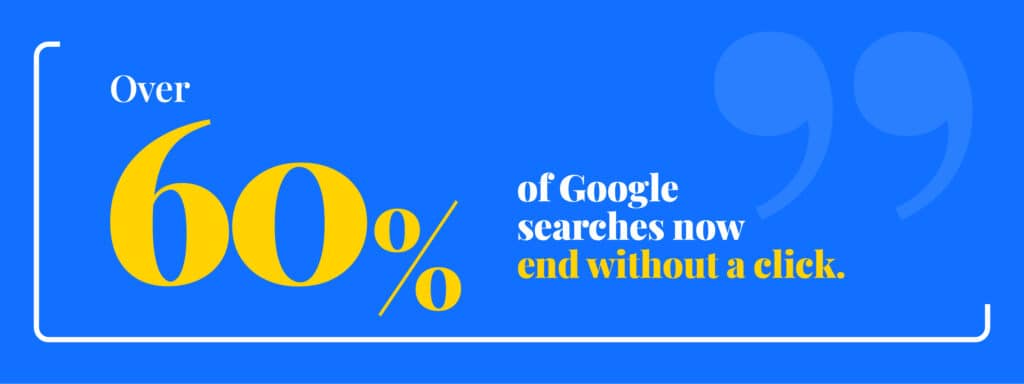Here’s the thing about content marketing that most agencies won’t tell you: creating great content is only 20% of the battle. The other 80%? That’s distribution. And if you’re a content marketing leader still treating distribution as an afterthought, you’re leaving serious money on the table.
The numbers don’t lie. Content marketing generates 3x more leads per dollar than traditional advertising, and email marketing alone delivers $38 for every dollar invested. But here’s the kicker: over 60% of Google searches now end without a click. Your content strategy needs to work in this new reality, not against it.

In this guide:
Key Takeaways
- Content formats must align with goals -Different types of content serve different purposes: blog posts and guides drive SEO, research and white papers build authority, and case studies and reviews provide social proof that supports conversions.
- Three distribution channel types form the foundation – Owned channels (websites, blogs, newsletters, podcasts, etc.) offer control and compounding value but have limited reach. Earned channels (shares, reviews, guest posts, mentions) deliver credibility but are unpredictable. Paid channels (ads, sponsorships, influencer partnerships) provide immediate visibility but require ongoing investment.
- Strategic distribution increases impact – Distributing content intentionally boosts visibility, engagement, brand awareness, and competitive advantage by ensuring audiences encounter content across multiple touchpoints where they already spend time
- Effective strategies require research and focus – Audience research determines which channels matter most. Rather than spreading thin, focusing on 3–5 key channels matched to audience behavior and content strengths yields better results.
- Planning and optimization drive consistency and ROI – A distribution calendar ensures sustainable execution, while continuous performance monitoring and optimization link efforts to real business outcomes (leads, conversions, revenue) instead of vanity metrics.
Types of Content for Distribution
Not all content is created equal when it comes to distribution. Smart marketers know which formats pack the biggest punch for their specific goals, whether that’s building brand awareness, driving engagement, generating leads, or moving prospects through the pipeline.
- Blog posts
- Educational articles
- White papers
- How-to guides
- Research studies
- Case studies
- Videos
- Podcasts
- Newsletters
- Reviews
Content Marketing Distribution Channels and Strategies
The distribution game comes down to three core channel types. Master these, and you’ve got the foundation for success.
Owned Channels
These are your digital real estate: the channels you control completely. We’re talking websites, blogs, email lists, newsletters, mobile apps, and your social media profiles.
Content that excels in own channels:
- Blog posts – Your SEO workhorses that establish thought leadership. You can transform single blog posts into comprehensive campaigns: information from you blog post can be repurposed out through your other channels and become the spoke in the wheel of a content ecosystem.
- Newsletters – Direct lines to your audience’s inbox. Monthly newsletters can form a permanent content ecosystem through archive content hubs that make past issues searchable, referral incentive programs that reward subscribers, and best-of compilations that highlight top content quarterly.
- Educational articles – Trust-builders that position you as the expert. Specialized industries like financial, medical, and high-tech excel here by creating comprehensive guides that live on their websites, driving organic search traffic while establishing expertise.
- How-to guides – Problem-solvers that drive organic traffic. A “How-to Guide” can be hosted on your website for SEO value, integrated into customer onboarding for new members, and featured in email sequences.
- Videos – The format 58% of B2B marketers rate as most effective. Host education videos on your website and YouTube channel, extracting podcast audio for companion shows and creating educational series for member benefit.
- Podcasts – Long-form content for building deeper relationships. Your podcast builds an owned audience through dedicated hosting on your website, transcript-to-blog transformation to turn episodes into SEO-rich articles, and archived content libraries.
The upside: Complete message control, long-term value building, and relatively low ongoing costs after initial setup. Your email list is an asset that grows in value over time, and SEO benefits compound month after month.
The downside: Limited reach. You’re mostly talking to people who already know you exist. Building these channels takes time and consistent effort, and you need to actually create content worth consuming.
Earned Channels
This is where other people do your marketing for you: shares, mentions, reviews, guest posts, media coverage, and word-of-mouth referrals.
Content that excels in earned channels:
- Research studies – Authority-builders that earn media coverage. Annual industry studies can earn visibility through press release distribution, conference presentation pitches at industry events, competitor mention strategies in publications, and data visualization campaigns (turning key findings into shareable infographics.)
- Case studies – Social proof that closes deals. Use your member success stories in customer advocacy programs, industry award submissions showcasing results, and peer referral campaigns where satisfied members share their stories organically.
- Reviews – Social proof that influences purchasing decisions. Share great reviews across social channels, integrate testimonials in sales materials, create review summary campaigns highlighting member feedback themes, and request video testimonials that generate authentic user-generated content.
- Educational articles – Trust-builders that position you as the expert. Earn coverage by contributing guest curriculum to educational programs, syndicating through industry newsletters, and getting featured through blogger outreach.
- White papers – Lead magnets that also establish thought leadership. Cybersecurity or financial wellness white papers earn industry recognition through conference presentation pitches, mentions in industry publications, and citations by other financial institutions.
The upside: High credibility since third parties validate your message.
The downside: You can’t control timing or guarantee coverage. When someone mentions you, it might not always be positive. Building relationships takes time, and results are unpredictable.
Paid Channels
Your accelerator channels: PPC ads, social media advertising, sponsored content, influencer partnerships, and native advertising.
Expand your content with paid distribution:
- Google Ads – Search and display campaigns that target high intent. Put your content in front of people actively looking for your solutions with keywords that capture prospects at the decision stage.
- Facebook and Instagram Ads – Visual storytelling platforms. Perfect for member testimonials, educational video content, and community-focused messaging. Use detailed demographic targeting to reach specific life stages or purchase triggers.
- LinkedIn Sponsored Content – The gold standard for B2B financial services content. Promote thought leadership articles, industry research, and educational resources to business owners, HR professionals, and other decision-makers who influence employee banking choices.
- YouTube Pre-Roll and In-Stream Ads – Video content that interrupts and engages. Use these for education series, product demonstrations, and member success stories that build trust through authentic storytelling.
- Native Advertising Platforms – Sponsored content that appears as editorial content. Perfect for distributing educational articles and guides to audiences consuming related content on news and finance websites.
- Podcast Sponsorships – Audio ads on relevant podcasts. Sponsor shows that align with your member demographics and values, for example, financial literacy programs and local business spotlights.
- Sponsored Email Newsletters – Use established email newsletter audiences. Partner with local business publications, chamber of commerce newsletters, and industry-specific email lists to reach targeted audiences through trusted sources they already engage with regularly.
The upside: Immediate visibility with precise targeting and clear ROI tracking. Modern platforms let you get incredibly specific about who sees your content when.
The downside: Rising costs and increasing ad blindness. Plus, the moment you stop paying, the traffic stops.
Why You Should Have a Content Distribution Strategy
If you’re still playing the “post and pray” game, you’re not letting your content shine. Here’s why you should be investing at least as much in distribution as in content.
Increased Visibility and Reach
Make your content show up where your audience is spending their time. Instead of hoping people find you, you’re putting valuable content directly in their path across multiple touchpoints. This is about being in the right places, consistently.
Enhanced Engagement
When you distribute content strategically, you’re starting conversations. 89% of B2B marketers now use organic social media for distribution because it creates opportunities for real engagement, not just passive consumption.
Improved Brand Awareness
Strategic distribution builds familiarity over time. When prospects see your content helping solve problems across different channels, you become the obvious choice when they’re ready to make a decision. It’s about earning mindshare before you need market share.
Competitive Advantage
Strategic distribution means you’re orchestrating where and when your prospects encounter your expertise. When they research solutions on Google, they find your optimized content. When they scroll LinkedIn during their commute, they see your thought leadership. When they listen to industry podcasts, they hear your insights. When they attend conferences, your research gets referenced. That builds huge brand affinity and buzz.
How to Develop an Effective Content Distribution Strategy
Ready to stop winging it? Here’s how to build a distribution strategy that moves the needle.
1. Conduct Audience Research
Understanding where your audience goes for information and how they prefer to consume content is key to reaching them. Are they LinkedIn scrollers or newsletter readers? Do they prefer video explanations or detailed written guides? Remember, mobile-first thinking is now standard.
Map your audience’s content consumption patterns to specific channels. If your members are active in local Facebook groups, that’s where you need to be. If they’re reading industry newsletters, you need to be too.
2. Define KPIs and Goals
Forget vanity metrics. Focus on numbers that connect to business outcomes. Email open rates matter, but conversion rates matter more. Social media likes are nice, but lead generation is better. Make sure you can justify content investment with real results.
Set specific targets: X new leads per month, Y% increase in organic traffic, Z email subscribers acquired. Then work backward to determine what content and distribution tactics will get you there.
3. Content Audit and Planning
Look at what’s already working. Which pieces drove the most leads? What content gets shared most often? What topics generate the most engagement? Double down on what works and kill what doesn’t.
4. Select Content Channels
Choose 3-5 channels max and dominate them rather than spreading yourself thin across a dozen platforms. Match channel strengths to content types: LinkedIn for thought leadership, email for nurturing, YouTube for educational content.
5. Create a Content Distribution Calendar
In addition to planning content themes, orchestrate campaigns across channels with a centralized distribution calendar with approval workflows to ensure consistency and prevent last-minute scrambles. The goal is sustainable consistency, not sporadic bursts of activity.
6. Conduct Performance Optimization
Set up tracking that connects distribution efforts to business outcomes. Multi-touch attribution reveals true impact better than last-click attribution, showing how different channels work together to drive conversions. Review performance monthly, optimize weekly, and test continuously. The channels and tactics that work today might not work tomorrow, so stay flexible and data-driven.
Conclusion
Don’t let your content live in isolation. The real impact comes when every article, video, case study, or podcast is part of an orchestrated distribution strategy that ensures visibility across owned, earned, and paid channels.
Think like a media company: plan campaigns, repurpose content, and deliver it where your audience already spends time. Your brand and your clients don’t just need great content ideas, they need those ideas amplified, discoverable, and measurable. When distribution is integrated into your process, your expertise doesn’t just exist, it drives awareness, engagement, and growth.
Session Interactive has 15+ years of experience helping organizations in specialized industries like B2B, financial, and healthcare turn content into measurable business results. We build distribution strategies across owned, earned, and paid channels that give your content legs.
Our team combines deep digital marketing expertise with data-driven strategies and collaborative mindset to help financial institutions maximize their content investment. Whether you need help developing a comprehensive distribution strategy, implementing advanced tactics, or optimizing existing efforts, we bring the analytical expertise and innovative thinking to drive real ROI.
Ready to stop leaving money on the table with your content marketing? Let’s talk about turning your content into a lead generation and member acquisition engine that works as hard as you do.





